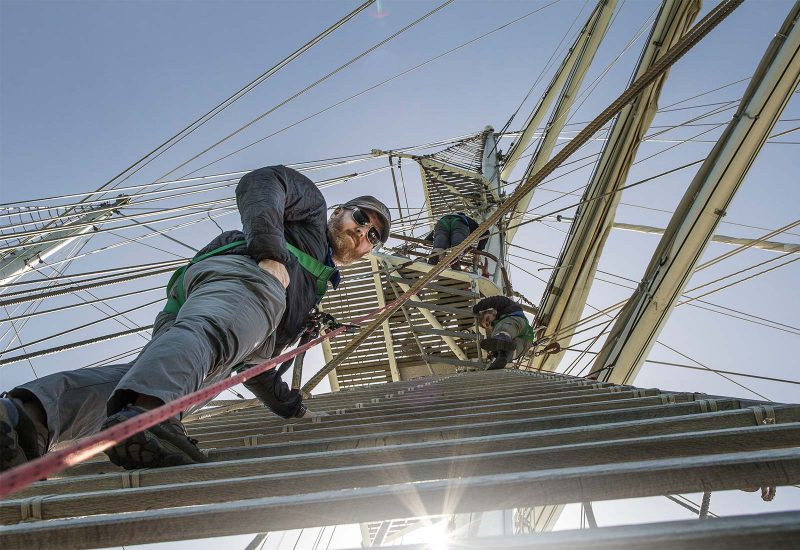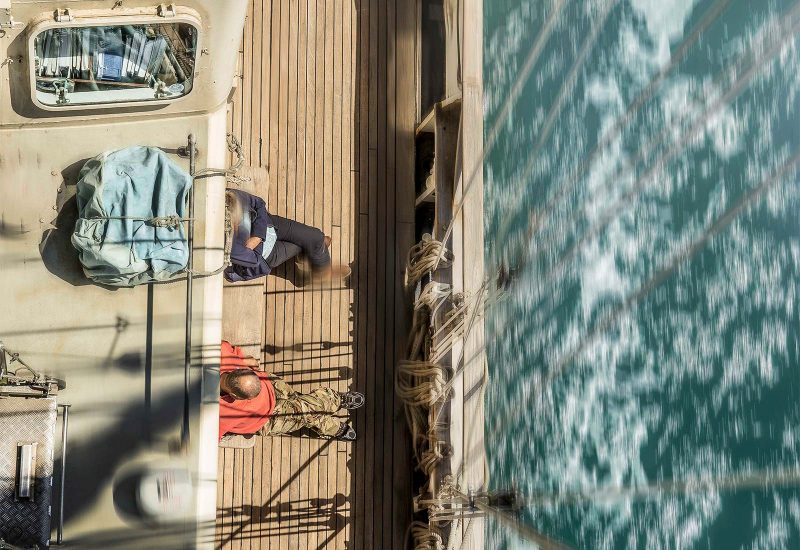8 Tips for Photographers on Boats and at Sea

The endless expanse of ocean and sky has drawn biologists, astronomers, and explorers out to sea for thousands of years. With low budget boat trips now readily available to most people, taking a camera out to sea has fast become a way for nature photographers to experience a wealth of wildlife and get uniquely beautiful photographs that simply weren’t possible before. After spending two months on board a sailing boat, and destroying a fair amount of my own equipment, it occurred to me that there were many things that I could have been better prepared for, and many things I wish I had been told before heading out to sea.
To save you the pain of a broken camera, and to get you on your way to stunning photographs of brooding skies and changing landscapes – here are a few handy tips for photographing at sea that you should know before taking to the water.


#1 Stability at Sea
A golden rule for photographing at sea is to always maintain three points of contact. This means keeping at least two hands and one foot, or two feet and one hand securely on the boat at all times. This simple rule will ensure that you don’t trip, slip, or fall as you take photographs. The rapid motion of waves will render a tripod useless on a boat, and so it’s best to try and use your body to create the shape of a tripod when keeping your camera steady. This can be done by placing both your elbows on your knees, or locking an arm or leg around a nearby rail or handle.
The shoes you wear will also play a large part in your stability whilst making your way around on deck. It’s best to use sailing boots, or hiking boots with non-marking soles for ultimate foot grip. You will need two pairs of gloves for your trip. One pair will need enough dexterity and grip to pull ropes, change the settings on your camera, and get in and out of your pockets quickly. Unfortunately, these gloves don’t offer the warmth that you need for longer sailing trips, or stay dry for very long. A larger pair of thermal gloves are good to have for longer periods that you may spend at sea.
#2 Securing Your Equipment
As you can only take soft luggage onto a boat, it’s important to prepare for a lack of space. For this reason, cutting down on your camera kit will be to your advantage. Personally, I like to replace the additional space I have made with extra padding or waterproof protection, just for extra assurance. This means that you can squeeze your bag into tight, enclosed spaces, without worrying that your kit will be damaged in the process.
Staying aware of your surroundings is extremely important when making your way around a boat. Try to feel how the boat is moving, and how that in turn will affect how your camera bag and equipment moves. Once you have this figured out, tie your bag down securely with straps or bungee cords in the most secure place.
#3 Weather Protection
Using a small waterproof case when out at sea is always a good idea, although these can unfortunately come with a heavy price tag. A cheaper way of keeping water off your camera is to tie a plastic bag around the body and lens, securing it with rubber bands. Sudden changes in weather can render water resistant materials useless, so it’s best to use waterproof rain covers on your camera bag and other equipment too, along with silicon moisture absorbers within your camera bag lining. Waterproof camera protectors such as the Meersee Universal Waterproof Camera Cover are also a good budget option for keeping moisture out of your equipment.
As well as protecting your equipment from the weather, it is important to protect yourself. Even in freezing temperatures, sunlight can reflect from the ocean’s surface and cause glare and sun burn. For this reason, packing sun cream and sun glasses is always a good idea, along with a tub of Vaseline, which will protect damaged and cracked skin on longer voyages.
Wind chill, is also a dangerous factor to ignore. As the wind strengthens out at sea, it draws heat from exposed skin, rapidly decreasing body temperature. For example, at a normal air temperature of 0 degrees Celsius on land, but with a wind of 40 knots out at sea, the temperature will feel like -10 degrees Celsius, rendering your usual jacket and scarf useless. For colder weather, it’s always best to keep some wool thermals on hand. A good way of preparing for a voyage is to look at a wind chill calculator online before you head out for the day. My favourite calculator to use is on the National Weather Service website.
#4 Salt and Rust
Although your main concern may be moisture finding its way into your camera, the real enemy that you should be worried about is salt. Salt water acts corrosively to the metal and circuitry in your camera, and can lead to excessive internal rust and damage if not properly cleaned from your camera body. Higher ranges of DSLR’s will be weather sealed, but for lower ranges without this feature, there are a few tricks to help prevent salt entering your camera. A simple way to temporarily seal your camera, is to place a rubber band or hair tie over the join between your camera and lens. However, it’s important to remember to remove these after a shoot, and gently clean the area with a moist cloth.
An easy way to avoid internal damage to your camera, is to completely avoid changing your lens when out at sea, and to gently wipe ports and buttons with a damp cloth after being outdoors. Pay attention to any white spots that you can see, these are a sign of salt residue. It’s useful to always have a cloth ready to immediately wipe away any salt spray on your lens during a shoot on the water. Once sea water dries, the salt acts as an abrasive and can scratch the lens glass as you clean it. This aside, using a UV or ND filter is the best way of completely preventing salt water coming into contact with the front of your lens.
#5 Seasickness
Although seasickness may be an obvious thing to consider during a shoot at sea, it’s important to not let this affect your photographs. Looking through a telephoto lens whilst dropping down the surface of waves is enough to make even the hardiest of stomachs lurch. Pure ginger, or ginger biscuits are a good way to settle your stomach whilst you are photographing, and avoiding looking down at your camera whilst changing settings will significantly reduce any nausea you may experience. Get comfortable with changing your camera settings without looking, you’ll thank me later!
#6 Staying Prepared
When a boat is in motion, it may be difficult, or even impossible to go below deck and change batteries or SD cards. For this reason, it’s important to always keep spares of everything in your pockets, in hardy waterproof cases. As moving images onto a computer may also be impossible for a few days at a time, taking plenty of SD cards with you will keep you shooting in the roughest of weather, as well as reducing the time it will take to delete photos manually from your camera.
#7 Safety and Tethering
As it can be tricky to keep hold of your equipment in bad conditions, it’s vital to keep your camera strap around your neck, and preferably use a secondary strap attached to your hand. In rough conditions, it may become necessary to tether yourself to the boat with ropes or a belt clip. Most importantly, becoming aware of the dangers on deck will help you manoeuvre yourself thoughtfully, as others handle steering, sails and ropes around you. For climbing masts, it’s essential that you secure your camera to your body with a secondary rope, as dropping equipment can seriously injure anyone who may be below you.
#8 Settings
A high shutter speed will become your best friend when photographing out at sea, allowing you to freeze motion as you rapidly pass wildlife or landscapes. This however can also mean that your photographs become slightly darker, and so it may be necessary to push your ISO a little higher than normal, especially when photographing the interior of a badly lit ship. Although you may spend much of your time fighting motion blur in your images, it can add an element of movement and emotion to your photographs. Stay creative, and watch out for opportunities where motion blur can work for you!
Although taking a camera out to sea definitely adds an element of risk to your photo shoots, experiencing a day away from land can open your eyes to the endless opportunities that the ocean offers. Remember to take care of your equipment, but most importantly – take care of yourself!












